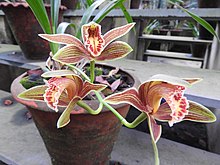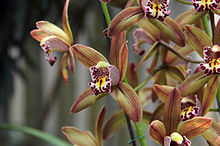Cymbidium
| Boat orchids | |
|---|---|

| |
| Cymbidium iridioides | |
| Scientific classification | |
| Kingdom: | Plantae |
| Clade: | Tracheophytes |
| Clade: | Angiosperms |
| Clade: | Monocots |
| Order: | Asparagales |
| Family: | Orchidaceae |
| Subfamily: | Epidendroideae |
| Tribe: | Cymbidieae |
| Subtribe: | Cymbidiinae |
| Genus: | Cymbidium Swartz[1] |
| Species | |
|
See text. | |
| Synonyms | |
| |



Cymbidium /sɪmˈbɪdiəm/,[2] commonly known as boat orchids, is a genus of evergreen flowering plants in the orchid family Orchidaceae. Orchids in this genus are epiphytic, lithophytic, terrestrial or rarely leafless saprophytic herbs usually with pseudobulbs. There are usually between three and twelve leaves arranged in two ranks on each pseudobulb or shoot and lasting for several years. From one to a large number of flowers are arranged on an unbranched flowering stem arising from the base of the pseudobulb. The sepals and petals are all free from and similar to each other. The labellum is significantly different from the other petals and the sepals and has three lobes. There are about fifty-five species and sixteen further natural hybrids occurring in the wild from tropical and subtropical Asia to Australia. Cymbidiums are well known in horticulture and many cultivars have been developed.
Description[]
Plants in the genus Cymbidium are epiphytic, lithophytic or terrestrial plants, or rarely leafless saprophytes. All are sympodial evergreen herbs. Some species have thin stems but in most species the stems are modified as pseudobulbs. When present, there are from three to twelve leaves arrange in two ranks and last for several years. The leaf bases remain after the leaf has withered, forming a sheath around the pseudobulb. The flowers are arranged on an unbranched flowering stem which arises from the base of the pseudobulb or rarely from a leaf axil. The sepals and petals are usually thin and fleshy, free from, and more or less similar to each other. The labellum (as in other orchids, a highly modified third petal) is significantly different from the other petals and sepals. It is sometimes hinged to the column, or otherwise fused to it. The labellum has three lobes, the side lobes erect, sometimes surrounding the column and the middle lobe often curving downwards. After pollination a glabrous capsule containing many light coloured seeds is produced.[3][4][5]
Taxonomy and naming[]
The genus Cymbidium was first formally described in 1799 by Olof Swartz who published the description in Nova acta Regiae Societatis Scientiarum Upsaliensis.[1][6] The genus name Cymbidium is derived from the Latin word cymba meaning "cup" "bowl" or "boat"[7]: 243 with the diminutive suffix -idium,[7]: 491 hence "little boat", apparently in reference to the shape of the labellum in some species.[5]
Species list[]
The following is a list of Cymbidium species accepted by the World Checklist of Selected Plant Families as at April 2020:[1]





- M.A.Clem. & D.L.Jones
- Quisumb. (Philippines)
- Cymbidium aloifolium (L.) Sw. aloe-leafed cymbidium (Himalaya to W. Malaysia)
- X.Y.Liao, S.R.Lan & Z.J.Liy (Yunan)
- (Lindl.) Rolfe (S. Thailand, W. & C. Malaysia, Philippines)
- Rolfe
- Gagnep.
- F.Y.Liu & Perner
- Cymbidium bicolor Lindl. : two-colored cymbidium (S. China to Trop. Asia)
- Cymbidium bicolor subsp. bicolor (S. India, Sri Lanka)
- Cymbidium bicolor subsp. pubescens (Lindl.) Du Puy & P.J.Cribb (W. & C. Malaysia)
- J.J.Wood (N. & NW. Borneo)
- Cymbidium canaliculatum R.Br. – channelled boat-lip orchid, tiger boat-lip orchid, native cymbidium or tiger orchid (N. & E. Australia)
- Z.J.Liu & S.C.Chen
- Cymbidium chloranthum Lindl.: green-flowered cymbidium (W. Malaysia)
- Cymbidium cochleare Lindl. (E. Himalaya to Taiwan)
- Z.J.Liu & S.C.Chen (Yunnan, SW China)
- Cymbidium crassifolium Herb.
- Wall. ex Lindl. (Himalaya to S. China and Philippines)
- Cymbidium cyperifolium subsp. cyperifolium (Himalaya to S. China)
- Cymbidium cyperifolium subsp. indochinense Du Puy & P.J.Cribb (Indo-China, Philippines)
- Cymbidium cyperifolium var. szechuanicum (Y.S.Wu & S.C.Chen) S.C.Chen & Z.J.Liu
- G.Q.Zhang & Z.J.Liu (Yunan)
- Cymbidium dayanum Rchb.f.: phoenix orchid, tree orchid, Day's cymbidium (Himalaya to S. Japan and Malaysia)
- Y.S.Wu & S.C.Chen (China)
- Paxton : Devon's cymbidium (Nepal to N. Thailand, Laos & Vietnam)
- H.He (Yunnan)
- J.M.H.Shaw
- Cymbidium eburneum Lindl. : ivory-colored cymbidium (Himalaya to Hainan)
- Cymbidium elegans Lindl. (SW China)
- Cymbidium elegans var. elegans
- Cymbidium elegans var. lushuiense (Z.J.Liu, S.C.Chen & X.C.Shi) Z.J.Liu & S.C.Chen
- J.J.Wood, Du Puy & Shim (NW. Borneo)
- Cymbidium ensifolium (L.) Sw. : four season orchid (Trop. & Temp. E. Asia)
- Cymbidium erythraeum Lindl. : Indian cymbidium (Himalaya to SC. China)
- Cymbidium erythraeum var. erythraeum
- Cymbidium erythraeum var. flavum (Z.J.Liu & J.Yong Zhang) Z.J.Liu, S.C.Chen & P.J.Cribb
- Cymbidium erythrostylum Rolfe : red column cymbidium (Vietnam)
- Rolfe : multi-flower orchid (Uttaranchal to Taiwan)
- Lindl. : Finlayson's cymbidium (Indo-China to Malaysia)
- Cymbidium floribundum Lindl. : golden leaf-edge orchid (S. China, Taiwan)
- Rolfe
- Hayata
- King & Pantl.
- Z.J.Liu & J.Yong Zhang
- Rolfe
- Cymbidium goeringii (Rchb.f.) Rchb.f. : spring orchid (Himalaya to temp. E. Asia).
- Lindl.
- Cymbidium hartinahianum J.B.Comber & (N. Sumatra)
- F.Muell. ex Regel
- Cymbidium hookerianum Rchb.f. (E. Nepal to S. China)
- Z.J.Liu & J.N.Zhang
- Rolfe : splendid cymbidium (N. Thailand to Hainan)
- Cymbidium iridioides D.Don : iris-like cymbidium (Himalaya to SC. China)
- Ying L.Peng, S.R.Lan & Z.J.Liu (Yunnan)
- Cymbidium kanran Makino : cold-growing cymbidium (S. China to S. Japan)
- Hook. : green-flowered peacock orchid, lance-leafed cymbidium (Trop. & Subtrop. Asia)
- M.Z.Huang, J.M.Yin & G.S.Yang (Hainan)
- Z.J.Liu & J.N.Zhang
- Cymbidium lowianum (Rchb.f.) Rchb.f. : Low's cymbidium (China to N. Indo-China)
- Cymbidium lowianum var. ailaoense X.M.Xu
- Cymbidium lowianum var. kalawense (Colyear) Govaerts (Myanmar)
- Cymbidium lowianum var. lowianum (China to N. Indo-China)
- Lindl. (N. Pakistan to Temp. E. Asia).
- Cymbidium madidum Lindl. : buttercup orchid, northern cymbidium, moist forest cymbidium (eastern Australia)
- Cymbidium maguanense F.Y.Liu (S.E. Yunnan)
- Cymbidium mastersii Griff. ex Lindl. : Masters's cymbidium (E. Himalaya to China)
- Z.J.Liu & S.C.Chen (Yunnan, China South-Central, temperate Asia)
- J.M.H.Shaw
- King & Pantl.
- Y.S.Wu & S.C.Chen (China (SW. Yunnan, SW. Guizhou), Hainan)
- Makino ex J.M.H.Shaw
- T.Yukawa & Nob.Tanaka
- X.P.Zhou, S.P.Lei & Z.J.Liu
- Z.J.Liu & S.C.Chen
- Y.S.Wu & S.C.Chen (China, Xichuan)
- Cymbidium parishii Rchb.f. (S. Myanmar)
- Z.J.Liu & S.R.Lan (China South-Central)
- L.J.Chen, Li.Q.Li & Z.J.Liu
- K.M.Feng & H.Li (China)
- Ridl. (S. Thailand, Malaysia, N. Borneo)
- Z.J.Liu, S.C.Chen & P.J.Cribb
- Aver. & Q.T.Phan
- Rolfe
- J.J.Sm. (W. Malaysia, S. Thailand)
- (Rolfe) P.J.Cribb & Du Puy (Vietnam)
- Rolfe (C. Vietnam)
- (P.J.Cribb & Du Puy) P.J.Cribb
- Schltr.
- G.Z.Chen, G.Q.Zhang & L.J.Chen (Yunnan)
- Z.J.Liu & S.C.Chen
- J.J.Sm. (W. Malaysia)
- (Andrews) Willd. : Chinese cymbidium (Assam to Indo-China, China, Taiwan)
- Cymbidium suave R.Br.: snake orchid (E. Australia)
- Sander ex C.H.Curtis (N. Myanmar, Vietnam)
- Aver. (Vietnam)
- Z.J.Liu & S.C.Chen (China)
- Cymbidium tigrinum C.S.P.Parish ex Hook. : tiger-striped cymbidium (Assam to China and Indo-China).
- Fukuy.
- Cymbidium tortisepalum var. longibracteatum (Y.S.Wu & S.C.Chen) S.C.Chen & Z.J.Liu
- Cymbidium tortisepalum var. tortisepalum
- Cymbidium tracyanum L.Castle : Tracy's cymbidium (SE. Tibet to China and Indo-China)
- T.Yukawa
- Y.S.Wu & F.J.Liu
- King & Pantl. (Sikkim)
- (Rolfe ex De Cock) Rolfe (China)
- Rolfe
Distribution[]
This genus is distributed in tropical and subtropical Asia (such as northern India, China, Japan, Malaysia, the Philippines, and Borneo) and Australia.[8] The larger flowered species from which the large flowered hybrids are derived grow at high altitudes.[9]
Uses[]
Use in horticulture[]
Cymbidium (abbreviated Cym. in the horticultural trade[10]) orchids are among the oldest horticultural orchids in the world and were mentioned in a manuscript from the Jin dynasty from about 200 BCE and by Confucius. Today they are among the most popular orchid genera in cultivation. They have decorative flowers spikes and are one of the least demanding indoor orchids. To flower well they need a distinct difference between day and night temperatures in late summer. Plants need to remain outside in autumn until night temperatures drop to near 0 °C (32 °F).[11][12][13]
Cymbidiums have few pests or diseases but can be affected by aphids, spider mites and virus diseases.[13]
Use in cooking[]
The species Cymbidium hookerianum is considered a delicacy in Bhutan, where it is traditionally cooked in a spicy curry or stew and called "olatshe" or "olachoto".[14]
References[]
- ^ a b c "Cymbidium". World Checklist of Selected Plant Families (WCSP). Royal Botanic Gardens, Kew.
- ^ Sunset Western Garden Book, 1995:606–607
- ^ Jones, David L. (2006). A complete guide to native orchids of Australia including the island territories. Frenchs Forest, N.S.W.: New Holland. p. 461. ISBN 1877069124.
- ^ "Cymbidium". Flora of China. Retrieved 11 January 2019.
- ^ a b Jones D.L.; et al. (2006). "Cymbidium". Australian Tropical Rainforest Orchids. Centre for Australian National Biodiversity Research (CANBR), Commonwealth Scientific and Industrial Research Organisation (CSIRO), Australian Government.
- ^ Swartz, Olof (1799). Nova acta Regiae Societatis Scientiarum Upsaliensis. Uppsala. Retrieved 11 January 2019.
- ^ a b Brown, Roland Wilbur (1956). The Composition of Scientific Words. Washington, D.C.: Smithsonian Institution Press.
- ^ "Cymbidium suave". PlantNET - NSW Flora Online. Retrieved September 25, 2018.
- ^ Cribb, P and du Puy, D The Genus Cymbidium Kew Publishing ISBN 978-1-84246-147-1, 2007.
- ^ Alphabetical List of Standard Abbreviations for Natural and Hybrid Generic Names, Royal Horticultural Society, 2017 https://www.rhs.org.uk/plants/pdfs/plant-registration-forms/orchid-name-abbreviations-list.pdf
- ^ "Cymdidium orchids". Australian Broadcasting Corporation. Retrieved 7 May 2020.
- ^ "Cymbidium orchid". Royal Horticultural Society. Retrieved 7 May 2020.
- ^ a b "Cymbidium (group)". Missouri Botanical Garden. Retrieved 7 May 2020.
- ^ Thapa, Laxmi. "Theresearch project on edible wild plants of Bhutan and their associated traditional knowledge" (PDF). Shinshu University, Journal of the Faculty of Agriculture. Archived from the original (PDF) on 18 July 2011. Retrieved 11 January 2019.
External links[]
| Wikimedia Commons has media related to Cymbidium. |
- Cymbidium
- Cymbidiinae genera
- Epiphytic orchids
- Taxa named by Olof Swartz


